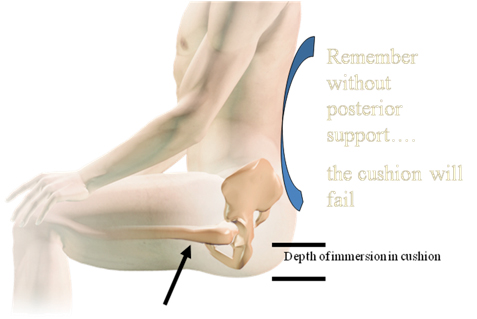Share:
Hello all!
In one of my previous articles, "More on Practical Seating Considerations – Posterior Pelvic Tilt", I wrote about the importance of the back rest when seating a client who presents with a posterior pelvic tilt. This month, I would like to talk about back rest selection in general.
The selection of an appropriate back rest for a client is important. The proper back rest can help to achieve numerous seating goals, which may include: positioning, stability, function, skin integrity, and/or increased sitting tolerance. As I have said during many seminars I have led, without posterior support, a cushion will not perform as intended. As the graphic below illustrates, the back rest provides support at the posterior aspect of the pelvis, which is necessary for achieving seating goals.

Even before we think about the back rest, we should take a moment to think about the spine. We should think about the natural curves of the spine and where the spine can and cannot take load. If the client has a flexible posture and can tolerate it, we would like to ensure that the natural curves of the spine are maintained by the seating system. We also want to respect the sacrum as ideally the sacrum should not take load.
Now let's assume that we have completed the full hands on-assessment and have seen the client out of his/her wheelchair in both sitting and supine on a firm surface. As I have said many times, it is only by taking the client out of the wheelchair and completing a full mat evaluation that we can begin to understand the client's seating needs. The assessment findings provide us with information regarding the client's presenting postures and trunk stability. We are assessing balance to determine if the client is independent, hands dependent or fully dependent when sitting at the edge of a firm surface. Finally, we look at body dimensions and record measurements. It is all of this information gathered from the hands on assessment that gets translated into generic product parameters for the back rest.
From the results of the sitting evaluation, and knowing where our hands needed to be placed in order to support the client, we now know the generic product parameters that are required for a backrest for the client. That translates into height of the backrest, the amount of lateral support required, and whether a unique shape must be accommodated through the backrest. Even with a supportive backrest, we should consider whether fixed tilt in the wheelchair, dump, or orientation in space (whatever you would like to call it) is required for optimal positioning for the client.
With respect to height of the backrest, often we specify the height of the backrest we want for a client. I think that this can lead to confusion when communicating with a vendor. If we do not specify where we want the back rest to start and end for the client, we are leaving it open to interpretation and possible error. And when we do request a particular starting point, is it based on a measurement from the height of the mat table or plinth? How does this measurement correlate to the height on the back cane of the wheelchair when the client is seated in his/her cushion? Remember, if the posterior pelvis is not adequately supported, the cushion will not perform optimally!
After considering the shape and contour of the backrest that is required for the client, other factors should be considered. For example, what height is needed for the back posts of the wheelchair? What are the dimensions of the wheelchair? If the client's upper body is narrower than her lower body, are inset back canes required to accommodate the difference? Will the hardware get in the way of the client's arm or arms as he/she propels? How easy is the mounting hardware to use to remove or place the backrest?
Another consideration for the back rest is the need for angle adjustability. The back rest may be adjusted to alter the seat to back angle either through the use of mounting hardware or through angle adjustable back canes on the wheelchair. In either case, we need to consider what, if any, seat depth will be lost and make accommodations for this if necessary.
After selecting generic product parameters required for a backrest, we can then trial the equipment with a client. Outcomes to assess include the client's function, sitting tolerance, and surface contact area with the back rest.
One size does not fit all for a back rest! We need to ensure that we are taking into account the client's presentation on the mat evaluation and translating this into generic seating product parameters specific for that client. Finally, we need to evaluate if the back rest meets the client's unique needs. A lot of clinical thought goes into each prescription!